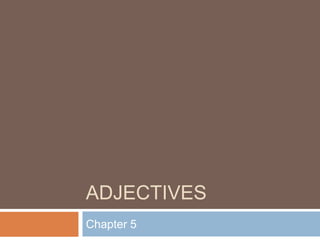Report
Share

Recommended
More Related Content
What's hot (19)
Angelica field study 3 (Conjunctions and Connectives)

Angelica field study 3 (Conjunctions and Connectives)
Similar to Chapter 5 adjectives
Similar to Chapter 5 adjectives (20)
The similarities and differences between spanish and english

The similarities and differences between spanish and english
More from spreaves
More from spreaves (20)
Chapter 5 adjectives
- 2. What are adjectives? In English, adjectives are used to describe. goofy green eager happy funny cute
- 3. Latin Adjectives In Latin, adjectives have all three genders. Right now we are only learning two of them: masculinefeminine laetuslaeta
- 4. The stem of and Adjective In order to find the stem of an adjective, take the feminine ending off the feminine form in the dictionary entry. laetus, laeta The stem is laet . Add the first and second declension endings to the stem.
- 5. Agreement Adjectives agree in GNC! Adjectives must agree with the nouns they modify in: Gender (masculine, feminine) Number (singular, plural) Case (nominative, genitive, dative, accusative, ablative)
- 6. IMPORTANT!!! Adjectives must agree with nouns they modify in gender, number, and case. They do NOT have to be in the same declension. This means that the endings don’t always match for the noun and adjectives.
- 7. Feminine Adjectives Feminine adjectives use First Declension endings.
- 8. Masculine Adjectives Masculine adjectives use Second Declension endings.
- 9. Examples Puellamlaetam “Puellam” is feminine, singular, accusative, so “laetam” must also be feminine, singular, accusative. Puerlaetus Puer is masculine, singular, nominative, so “laetus” must agree. *Notice that they do not have to LOOK alike in order to agree.